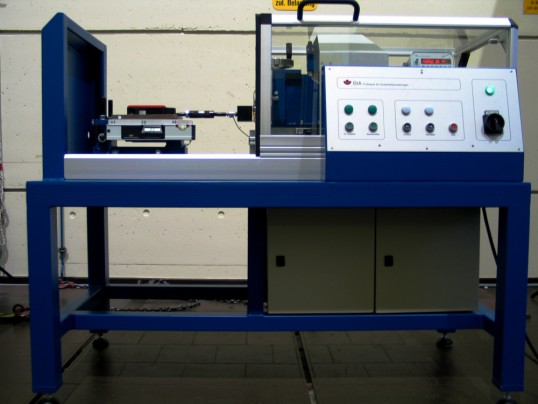- IFA-tested products and firms
- Testing according to the PPE regulation
- Testing according to machinery directive
- Testing according to the product safety act
- Testing floor coverings
- Testing soundlevel meters
- Testing grinding tools
- Testing abrasive agents
- Testing of temporary floor coverings
- Testing QA systems according to PPE regulation
- DGUV Test-mark
- Order forms
- Test equipment developed by IFA
Testing machine for interlocking devices with guard locking
Equipment description

Overall view of the testing machine for interlocking devices with guard locking
Source: IFA
Development occasion and background
Interlocking devices with guard locking are used on many machines and industrial installations to monitor the position of safety guards. The safety-relevant failure of a guard locking device was the cause of a near-accident. An investigation of the accident gave rise to a modification of the "Principles of testing and certification for interlocking devices with solenoid guard-locking" (GS-ET-19 (PDF, 264 KB)) defined by the German institutions for statutory accident insurance and prevention. For an effective implementation of locking force tests, a suitable testing machine was needed.
Structure of the testing machine
The test specimen is mounted on a universally adjustable clamping plate. A spindle drive powered by an electric motor loads the specimen in the "safety guard opening" direction with a constant velocity of 10 mm/min. A force measuring system determines the maximum forces encountered in this process. To determine the maximum locking force, the test specimen is loaded at its worst case angle of actuation until the interlock function fails. The testing machine is rated for a maximum tensile force of 10 kN.
For protection against fragments splintering off during the tensile tests, the testing machine is equipped with a safety hood. The position of the safety hood is monitored by an interlocking device with guard locking. The testing machine can only be started up when this safety hood is closed (interlocking). While the machine is in operation, the safety hood cannot be opened (guard locking).
Use
Two testing machines were built and are now used within IFA and by the German Social Accident Insurance Institution for the energy, textile, electrical and media products sectors for testing the locking force of interlocking devices with guard locking.
Contact
Accident Prevention: Digitalisation - Technologies
Tel: +49 30 13001-3520Fax: +49 30 13001-38001